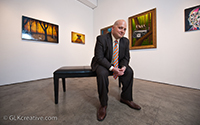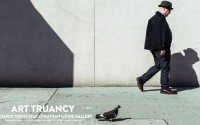The Color and the Fury of Jonathan LeVine

Words by Robert Aloia, Founder of Outlaw Arts
First off, I had to ask, and it’s pronounced as spelled: LeVine not Levine. It’s not about pretension, it’s a family thing going back generations. Embarrassed to say, I had blanked on the 10-year retrospective, The Color And The Fury, in February and lucky for me he wouldn’t let me leave without a signed copy of the accompanying book, Delusional.
From NJ to NY to Philly and back, he has always kept an underground punk, blue-collar, DIY, entrepreneurial spirit. Though he has attained much success, he’s still that “fuckin’ dude from Jersey,” eager to say “fuck you!” to the elitists.
Sticking to his ‘delusion’ while accepting his limitations and overcoming rejection after rejection, going by the old colloquialism “you have no business thinking about what others are thinking about you.”
One may not see the arc since he’s had so much success for a minute now, but he started curating at the legendary Maxwell’s in Hoboken, then CBGB’s Gallery, and occasionally Max Fish. Making the transition from doing shows in bars to respected gallery guy is not easy, and a path I find myself on as well. So, the little time I get to spend with him, I soak up his wisdom like a sponge.
_The Holmby Hills, 10pm (2013).jpg)
Josh Agle (Shag), The Holmby Hills, 10pm (2013)
Coming out of art school in the early ’90s, he wanted to do something fun, as a response to the money and classicism of the gallery/art scene at that time. We all know how that has worked out. Along the way, he’s had tons of fun—and still does, making sure to find the time to do so. Tonight just happens to be his band practice night. After our little chat, he’ll finish up here and head to jam with the guys. All accomplished musicians (Jonathan, the drummer), this is a true labor of love and they may never play out—or they may, but that’s not the point. That right there is a great place to be. He practices everyday and has some goals, like being able to record with Steve Albini. Coming from a family of musicians, he eschewed the lure of the music industry, which at the time seemed straight up “gross,” which is about an honest assessment as I’ve heard.
It is this part of him that is his charm and to some a detraction. While garnering an awesome roster of artists, press, buyers and fans, he somehow gets turned down for Armory and other big fairs due to “intellectual parameters,” i.e. politics. But the beauty of what he has accomplished is that he did it by not changing who he is, and fairs will not make or break him. Though if he does do Basel this year, I can’t wait to see what he puts together.
We spend most of our time talking family histories, traveling (Italy is his next destination), catching up on mutual friends, and of course art, while lounging in his office sipping on fine silver tequila.
.jpg)
DALeast, I (2014)
Mass Appeal: Sorry I missed the opening can you tell me about your 10-year retrospective, The Color and the Fury?
Jonathan LeVine: For our 10-year anniversary, I decided to do something a little different than what is normally done, such as putting together a group show with all of the artists I work with. I have produced so many shows like this in the past that it seemed a bit boring to me. For example, last year we hosted the 20-year Anniversary of Juxtapoz Magazine. And the year before, we did a giant group show celebrating 10 years of the Wooster Collective. I feel if I had done a group show, I would have been repeating myself. Instead, I decided to do a print show. I chose 10 artists to create 10 different limited edition prints, which we then exhibited in the gallery. We also created a commemorative installation on one wall that displayed postcards from the past 10 years, photos, drawings by artists, and various other things that represented the gallery. We made a fanzine that included past photos and writing by different artists and some past and present employees. We also gave out a bunch of fun, novelty items at the opening, such as stickers, buttons, and ice-cream sandwiches.
Coming out of art school envisioning a career in art, how close has your path come to that vision?
I wasn’t really sure what I was going to do when I came out of art school. I envisioned myself as more of a sculptor/musician/performance artist. I had not really embraced my entrepreneurial side and was sort of fighting it until I opened my first gallery at 32. It was hard to give up on the idea of being in the spotlight and having to accept being the behind-the-scenes guy. That being said, I have sort of carved out a niche that feeds my creativity in a variety of ways.
.jpg)
Jeff Soto, Monster (2012)
Who have been integral parts of your growth/success so far?
I have been fortunate in some ways, and I have met great people along my journey who have been extremely supportive of me. I started curating shows out of bars in NYC when I was 26, and during this time, I met many people who became my friends and supporters. Some of these early people were Ron English (artist), Carlo McCormick (art critic/writer), Erik Foss (artist/bar owner), Jordin Isip (artist), Eric White (artist), and the list goes on and on. We all sort of had the same vision about art, which was rare back then. I was given a few great opportunities to curate shows at legendary rock and art bars like Maxwell’s in Hoboken, NJ; Maxfish on Ludlowm and CBGB’s Gallery. Without these places, I would not have had a platform and a place to learn my craft so to speak.
The Armory and others fairs just passed. Are art fairs essential? Do you want to participate?
I think participating in art fairs on some level is essential, but it kind of depends on what one expects from them. At this stage in the gallery’s life, we are very strategic and selective about what fairs we participate in. We have kind of outgrown the satellite fairs, as there isn’t much financial reward or publicity we can’t get on our own. Ideally, I want to participate in the blue chip fairs like Basel, Frieze, and the Amory show, but it has been difficult to get accepted in these fairs, as we are still viewed as outsiders in some capacity.
Alex Gross, Spores (2014)
Do you have a personal/professional ethos?
My ethos is to strive to be as honest as the day is long; follow your passion first and financial gain second. Treat people fairly at all times, and try to be the bigger person when things go awry. Follow your instincts and don’t compromise your values, ever. If it doesn’t feel right, don’t do it. Strive to fight the good fight.
Playing music: hobby, first love, ultimate goal?
I would say music is my first love, but it is not my ultimate goal. I enjoy listening to music and playing music. I play the drums and try to practice every day. I have no goal of being a professional musician. If I am able to play with my friends and be happy with what we create, then that’s good enough for me. I see playing as an ever-continuing process of exploration and learning.
.jpg)
AJ Fosik, The Savage Wellspring of All Endeavors (2013)
Best thing about the new NYC?
It’s safe.
Worst thing about the new NYC?
It’s boring and has lost its edge. I liked it better when it felt a bit more like the Wild West. It’s become too homogenized.
Is the traditional art world as snobby and stuffy as one would think?
I think it’s probably a lot more relaxed than it used to be, but I still don’t care for it. I find so much of it pretentious and inaccessible. That being said, if you are patient, you can find really interesting and down to earth people. I just don’t always have the patience to wade through it.
.jpg)
Shepard Fairey, Lotus (2011)
People are embracing your approach to gallery direction: do you see continued growth or will it remain a niche?
I believe it will continue to grow. I don’t think it will remain a niche. I see more traditional galleries adding artists to their roster that are similar to ours more often. With the success of artists like Kaws, Os Gemeos, Barry McGee, Shepard Fairey, Mark Ryden, Swoon, JR, and Faile, you can see the change happening. Also, mega-star artists like Jeff Koons and Takashi Murakami are not so different then a lot of the artists I work with. The pop aesthetic continues to grow in the fine art market.
Is street art just a marketing tool at this point, or a valid art form?
That’s a good question. I think it’s become more of a marketing tool then what it used to be. The pioneers of the movement were more about interacting with the environment then making an art career out of it. That being said, I like the new group of mural painters that are coming up. It’s become something different of which I have embraced. I see better quality painters coming out of this international street art/mural movement. I am enjoying the ride and loving the way the community grows and interacts on this international level. I like the fact that people are having fun and it doesn’t need to be so serious all the time. I think the general public responds well to it and is paying attention to the visual arts more as a result. This is a very good thing in my opinion.
.jpg)
Tara McPherson, The Crystal Waterfall (2013)
http://massappeal.com/the-color-and-the-fury-of-jonathan-levine/




.JPG)


